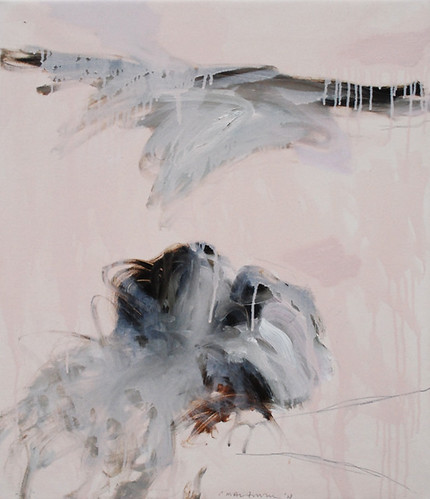
One could be forgiven for presuming, at first glance, that this was the work of Twombly. But in a minute one realizes that this is neither Twombly nor a look-a-like effort. Philip Maltman is his own man and in complete control of his very honest oeuvre. These beautiful gestures and colors are his alone. I was hard pressed to find one or two images to post that would best represent him. His oeuvre is definitely not formulaic and at times wide ranging. Upon finding Mr Maltman's work on the Web, I searched everywhere, trying to find more examples and information and when finally I was able to contact him, he generously responded. The question I pressed him with was - Just exactly how do you go about doing what you do ? He's well represented on the Web and I had already read several of his "Artist Statements", but I wanted to know what made him pick up a brush and go about painting the way he does in layman's terms.
Here was his straight forward response:
"Philip Maltman - Notes on Painting October 2008
It always begins with looking. A beach, a landscape, a garden, a table littered with natural objects, things which I regularly photograph. I print images and draw selected sections. These are pencil and watercolour sketches which are like a “loosening up” or training session. I do not deliberately use these as preliminary sketches. I will occasionally exhibit them but more often than not they remain in sketchbooks to be scanned from time to time as “aides memoire”.
In the studio I will look at the photographic images say, a group of stones, shells, seaweed with sunlight reflecting off interspersed pools of seawater.
I will choose a colour for the ground anything from white through greys to pinks and purples to black. This ground can be dependent on the colour of sand in the original, or maybe sampled from the original digital photograph with Photoshop which can throw up interesting surprises.
Occasionally as in a recent landscape based picture, the whole ground was painted pink because a couple of patches of light in a distant field were pink. Preparing grounds, which are always one colour, is an ongoing activity. Experiments in colour are also made without reference to source material.
Back to the beach then, I will paint the stones, shells, seaweed, and light in broad strokes, not descriptive detail, using oil paint. While it is still wet I will very quickly work into each area of paint with my fingers aiming to destroy the figurative element of the image and create an abstract “equivalent”. This has to work first time so there is a bit of the Zen Calligrapher’s practice in psyching oneself up ready to pounce. But of course if it doesn’t work I will modify with washes of white spirit, sometimes bitumen is introduced with some diluted oil to colour it. Usually I allow the liquid paint to run vertically to further destroy illusions of pictorial space.
I am aiming at a flat surface with coloured marks which might evoke a feeling of the original image although not in a figurative sense.
Next, using amongst other drawing materials, pencil, oil pastel and wax crayon I will improvise a sort of skating across the surface of the work highlighting, circling, scribbling and generally drawing into and around the paint. Words, letters, and numbers are always a temptation at this stage but I find it difficult to compose and position areas of text.
I will often acquire maps/charts of the areas that I am working on so numbers and letters can be “legitimately” incorporated. I feel that I need an overpowering non-sentimental reason to introduce what I feel is essentially an entirely separate art form (writing) and the reason is rarely there.
Single letters are more abstract, signs and symbols which usually refer to objects from the original image are used along with the letters and numbers from the charts.
These devices are used to make the surface of the painting reflect an existence which has innumerable layers of invisible waves, rays, signals, gases and creatures; imperceptible causes and effects; constant changes in light, sound, air pressure, weather - Life!
Everything is buzzing with atomic vibration therefore painting can never be still. That said, I can be persuaded by the work in progress to slow down and add/subtract marks, washes words and colour.
I participate with paint and I love its movement. I feel a strong relationship with all my materials and whilst they do not always co-operate they definitely participate like a group of dancers (Contemporary Ballet).
When a painting is finished or stops it is as if the dancers are exhausted, what’s done is done and can never be repeated exactly. But we will, of course, try to do it all again tomorrow! "
He may be on the other side of the planet, but it feels like a discussion over tea. I was already a fan, but after reading this I saw his work in a better light; it made more sense and had more depth, more meaning.
You'll want to visit all the links below because all the works are different and you can see just how he leans in different directions.
Escape Bar & Art (scroll to the bottom of page)
And here's a real treasure trove; Maybole.org - 10, Paintings 1, Paintings 2 & Paintings 3



No comments:
Post a Comment